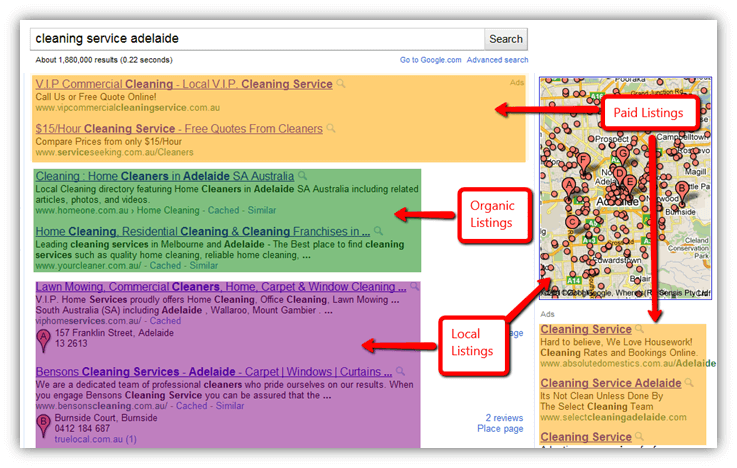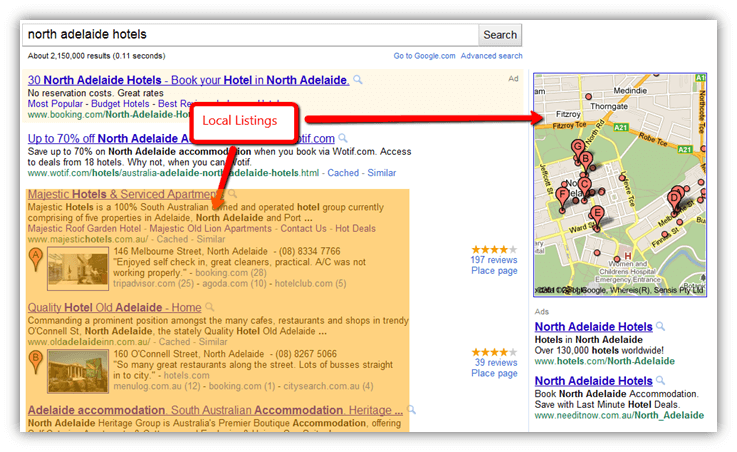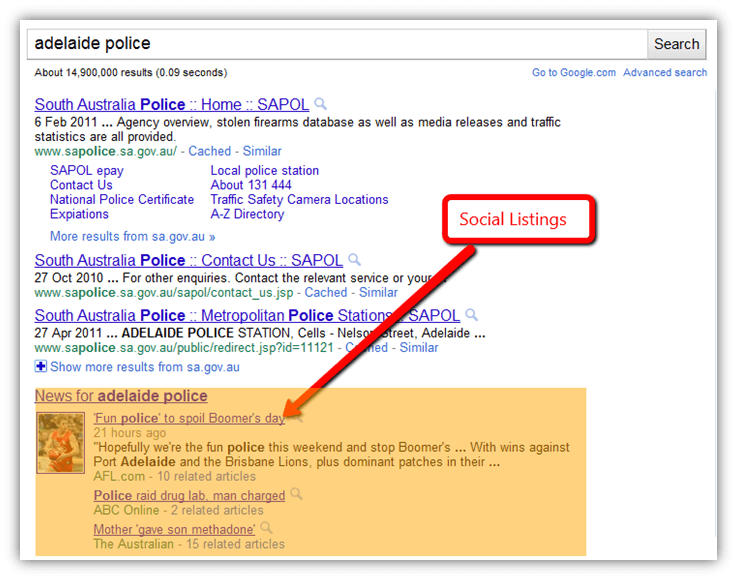For those of us that have been in the online marketing industry for many years, we’ve seen gradual, but significant changes to the SERP (Search Engine Results Page). You might notice that sometimes there’s search results that appear in a different format – or perhaps sometimes a map appears with search results.
Why does this happen?
Where Are The Listings Displayed?
It’s generally a search by search result, but here’s a SERP that might be displayed for the search term ‘cleaning service adelaide’.

Paid Listings
What Are They?
Paid Google listings; also known as Adwords, sponsored links or a myriad of other nicknames are paid positions within Google. An advertiser positions their ad in this section of the search listings and are charged (by Google) every time someone clicks on the ad. It’s a semi free market and generally the more you are willing to pay, the higher up in position you will occur.
Where are they displayed?
Paid Listings tend to ‘wrap’ themselves around the top right hand corner of the search results and are orange highlighted in the above example. 1, 2 or 3 paid listings may appear at the very top of the search results (in the above example it’s only 2) whilst the rest of the Paid Search results will be displayed on the left column.

Advantages of a Paid Listing
Provided you have given Google your billing information, your ad can be up and running in a matter of minutes – you can even be the top position for your primary keywords.
Disadvantages of a Paid Listing
Adwords is easy to learn but very difficult to master, for competitive niches an Adwords campaign turns into a complex optimisation problem as all advertisers compete against each other for profit share. If you are paying for traffic to your website you have to ensure your design is stunning, content is inspiring and have clear website goals created and being tracked.
Organic Listings
What Are They?
Organic listings are also known as natural listings or free listings and take up the bulk of the search engine results page. Obtaining a position on the organic listings is achieved through Search Engine Optimisation (SEO), which is the process of ensuring that your website has the most relevant match to the searched keyword.
Where are they displayed?
Organic listings will appear in the ‘body’ of the search engine results page and depending upon Paid and Local listings they might even appear at the very top. In the above example the Organic listings are green highlighted are positioned between the top paid listings and local listings. They can be identified from a local listing as they do not have the ‘red marker’ that’s associated with local listings.
.png)
Advantages of an Organic Listing
This listing space is free and is arguably more trustworthy than Paid Listings. Organic listings may be very profitable provided you can get in a high position for a high searched keyword.
Disadvantages of an Organic Listing
The algorithm that Google has created to decide which web site is ranked in what position is very complicated. Not to mention it changes all the time making it very difficult for SEO companies to guarantee positions for competitive keywords. In some circumstances achieving high rankings organically may be very expensive (in time and resources) not to mention unpredictable and difficult to measure the ROI.
Local Listings
What Are They?
Local Listings are search results that appear alongside a red marker and may often be displayed next to a Google Map. These are highly relevant local business search results based on your search query, and will most probably include the name of a town, or city.
Local listings are linked to a company’s Google Place Page.
Where are they displayed?
They appear only in about 15% of all search results and are mixed throughout the organic listings. As mentioned they are accompanied by a red marker and will display the business address and will contain the text ‘Place Page’ alongside the listing.

Advantages of a Local Listing
This listing space is free and is great for branding and capturing a local audience. The optimisation process for a local listing is less complicated and generally easier for skilled marketers to obtain a high position (relative to pure organic listings).
Disadvantages of a Local Listing
Local Listings only appear for 15% of all search queries, so relative to organic listings your local listing will capture less traffic.
Social Listings
What Are They?
Social listings tap into social media networks such as Twitter, Google News, and Facebook to display relevant results on the SERP. They are highly fresh results that match your search query.
Where are they displayed?
Social Listings can appear above, below or in between a mix of organic and local listings. They generally results from Google News but can be results from social networks such as Twitter.

Advantages of a Social Listing
Social Listings are in real-time and can be updated live on the SERP. If you are able to obtain a social listing you will most likely receive a high amount of traffic over a short time.
Disadvantages of a Social Listing
Social Listings are relatively new and are difficult to track separately from true organic traffic. The commercial intent of someone that clicks on a social listing is most likely very low, they are information shoppers and will have a high bounce rate.
The Future
Google makes generous investments into the structure of their search results to give the most relevant results to your search needs. The future is going social which is evident with Google’s new +1 functionality.

Comments (0)